|

foreword by Marshall Masters
03-August-07
from
Yowusa Website
For years, we've discussed Planet X and
2012 with a "you should become personally informed about this" sense
of urgency. Now, the dialog is changing, because our Earth is
changing.
Of particular note for Americans this month was an article published
in the journal Philosophical Transactions of the Royal Society of
London. It states that "the frequency of Atlantic hurricanes has
doubled over the last century."
Sure, the hurricane season runs from the 1st of June to the 30th of
November and has been unremarkable so far. However, the maximum
activity usually occurs in early to mid September, and given what is
currently happening on the other side of the Atlantic, let’s not be
complacent.
A high profile string of bizarre, weather-related calamities is
plaguing Europe this summer with a staggering number of fires,
droughts and floods. Massive fires have swept through the Canary
Islands and Greece. Overall, Great Britain seems to be getting the
worst of it by some estimates.
April was England's hottest on record, with very little rainfall.
Then, nature took a nasty turn, and then on came the floods. In
June, thousands were flooded out of their homes in Yorkshire,
Lincolnshire and Wales. In July, hundreds more were flooded out of
their homes in Oxford when tributaries of the Thames overflowed.
This is just a small sampling of what is happening — now!
To all those who attribute this ever-quickening global patterns of
violent weather to "natural cycles" and caution us not to take all
this to heart, we have a vital message for you:
"One should never underestimate
the power of human stupidity; because the 'stupids' do most
of the dying."
—Marshall Masters
Planet X Forecast and 2012
Survival Guide
Jacco van der Worp, MSc
Marshall Masters
Janice Manning
Excerpt from
the Introduction
Planet X is a generic term used to describe a large and yet unknown
object in our solar system. Known as Nibiru to the ancient
Sumerians, it is many times the size of the Earth and has a long
period orbit of approximately 3600 years. The date of 2012 generally
identifies a period of cataclysmic events predicted by the ancient
Mayans.

What is Planet X?
It could be a comet, rogue planet, or as
this book maintains, a dying brown dwarf companion to Sol. In the
years to come, its elliptical orbit will bring it into the core of
our system, where it will enrage our Sun. Once that happens, Earth’s
greatest pains will come; the moment fate puts us in the cross hairs
of a perfect solar storm.
Whatever this massive perturber proves itself to be, the search for
Planet X essentially dates back to the discovery of Uranus in 1781.
Described in numerous ancient texts and folklore of indigenous
peoples all around the world, the predictions of its return are
numerous.
The scientific harbinger data of this impending flyby is also being
reported at an ever-increasing pace and can no longer be ignored.
This is why many who have investigated the matter on their own now
believe the time has come to take action. In essence, they already
‘get it’ and now they’re feeling the need to get through it!
The purpose of this book is to help those who now agree that time is
of the essence. It does this by offering a practical 2012 tool kit
of how-to survival knowledge, for those who’ll be left to fend for
themselves.
Regardless of whether you can afford to build a bunker or can barely
afford a shovel, the information in this book is designed to be
equally useful. This is because the key to surviving
2012 is more
about what’s in your head than what’s in your wallet.
There are no guarantees. The best you can do is to enhance your odds
of survival, which does not necessarily mean building a better
bunker. Rather, as Louis Pasteur so aptly explained, “Chance favors
the prepared mind.”
Pasteur’s message for 2012 is clear. The better prepared you are,
both mentally and emotionally, the more likely you’ll be to
recognize and capitalize upon survival opportunities in a timely and
useful manner.
Therefore, the first step towards bettering your odds is to hardwire
your mind for survival. No rocket science is required — just a
little time. The process is simple, and this book will show you how
easy it is to get started.
The sooner you begin, the better your
odds of survival will be.
Planet X
Threat
The greatest threat we face is not Planet X itself, although it will
pelt the Earth with horrific meteorite storms and impact events.
Rather, it will be the catastrophic interactions between it and our
Sun.
Suffice it to say we are not threatened by one single object or
thing in 2012. Nor will we experience a single day of cataclysm, in
a Biblical sense. What can we expect? A slow motion train wreck for
the world, as we know it, and on a global scale.
As it has in the past, the Planet X flyby will trigger a convergence
of multiple manmade and natural catastrophic events, which will
occur over a period of years. Once the nightmare is over, the
survivors will emerge to create humanity’s next golden Renaissance.
In the meantime, when will this cosmic train wreck begin? It already
has.
The Planet X
Panic
The current global warming debate has achieved one notable result.
Paralysis. As the old saying goes, seeing is one thing and believing
is another. When our attention is being deflected away from what
really matters, what are we to believe? Or do we even care?
This seems to be more the case for global warming, because for as
long as conjecture can be used to deflect attention away from this
serious (and expensive) threat, that is exactly what most people
will do. Be deflected — and happily so.
The reason why this global warming deflection works as well as it
does, can be attributed to an inconvenient omission. The closing
distance between Planet X and our Sun is the primary causality for
global warming on Earth.
The same holds true for Mars and Pluto, which are also evidencing
clear signs of global warming. Therefore, many of the global warming
issues are indeed cyclic because Planet X flybys are cyclical in
nature.
Man-made pollution is very real, but it only aggravates the core
problem. Nonetheless, it remains a grave concern. This is because
we’re pushing the resiliency of our biosphere ever closer, towards
the tipping point of catastrophic failure.
All the data is there, but what’s missing? The context of an
inconvenient omission.
Without the proper context, Earth change concerns are unlikely to
serve as mainstream proof for Planet X. Furthermore, corporate news
media outlets will equivocate about the presence of this threat for
as long as possible. Their aim will be to prevent a public panic.
After all, that would stop most people from showing up for work and
paying taxes.
Therefore, the debate will ramble on until something greater
throttles it. That will be Planet X as it approaches the core of our
solar system. A large ball of dust and debris will precede it, much
like a royal procession. In time, it will encroach upon the space
surrounding Earth, and this is when the mainstream will really start
to ‘get it.’
At first, we’ll begin to see communication outages, as Planet X
takes the joy out of channel surfing. Cable television networks will
be especially vulnerable, because they depend upon communication
satellites in geosynchronous orbit.
Distance is a difference between these cable television satellites
and the Global Positioning System (GPS) satellites used by the
navigation systems used in military vehicles, airliners and
automobiles.
A geosynchronous orbit (GEO) allows a satellite to match the Earth’s
own 24-hour day. Consequently, it is always pointed at the same spot
on Earth. This is called a footprint, and what makes it work is the
fact that the satellite is parked in space at a distance of 22,369
miles (36,000 km) from the Earth.
On the other hand, a satellite in a low Earth orbit (LEO) is going
to be somewhere between 124 to 1,243 miles (193 to 2,000 km) above
the surface of the Earth. To help put this in perspective, the LEO
of the International Space Station (ISS) is 207 miles (333.3 km)
above the Earth.
So then, how does this play out?
As dust and debris from Planet X begins to impact the GEO satellites
used by the cable television networks.
This is when we’ll start to
see entire blocks of channels going off the air as satellite
transponders become damaged and fail.
Initially, these interruptions will be manageable, as these GEO
satellites typically handle scores of channels. Switching affected
broadcasts to other transponders on the satellite will quickly
restore programming. However, over time, increasing impact damage
will leave increasing numbers of GEO communication satellites
impaired or useless.
What viewers will see as we approach
2012
will be more interruptions
and progressively fewer channels. During this time, the cable
television networks will scramble to switch over to underground and
sub-sea fiber optic communication networks. However, they’ll have to
compete for fewer and fewer resources, so there will be no easy
panacea there.
Eventually, we’ll return to the 1970’s era of cable television with
somewhere between 20 to 40 channels of programming. Even with all
this, many will continue to let Planet X debunkers deflect their
concerns.
When will the mainstream finally ring the alarm bell? Odds are, when
the ball of dust and debris surrounding Planet X finally reaches low
Earth orbit. This is when NASA will likely be forced to abort a
manned LEO mission.
Worse yet, astronauts aboard the International Space Station (ISS)
could suddenly be forced to abandon ship and return to Earth in an
emergency evacuation craft. If ground controllers cannot maintain
the station’s orbit, the ISS will fall back to Earth in an
uncontrolled, fiery descent. This is when the Planet X bells will
ring for sure.
Planet X
Forecast for April 2007 to July 2014
|
 |
|
Slide # 2 |
Slide # 3 |
Slide # 4 |
|
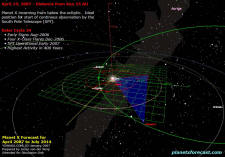 |
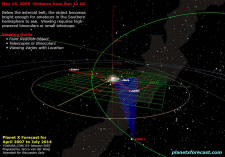 |
 |
|
Slide # 5 |
Slide # 6 |
Slide # 7 |
|
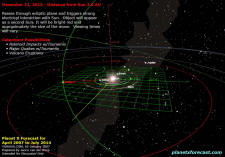 |
 |
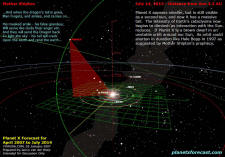 |
|
Slide # 8 |
|
Slide # 9 |
|
 |
|
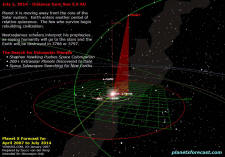 |
|










